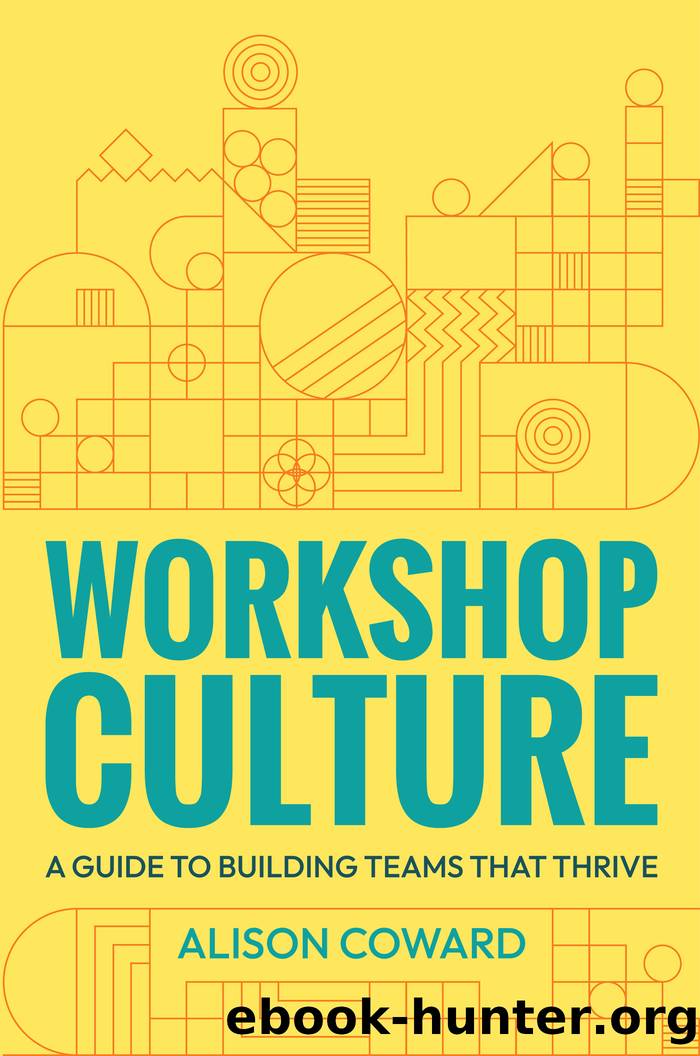Workshop Culture by Alison Coward

Author:Alison Coward
Language: eng
Format: epub
Publisher: Practical Inspiration Publishing
Published: 2024-11-15T00:00:00+00:00
By the end of this chapter, you will have learnt:
⢠a range of tools and techniques to help your team build self-awareness
⢠the conversations that encourage empathy and mutual growth in your team.
CASE STUDY: solving a personality clash
Even when a team is aligned on the bigger picture, a personality clash can still be a barrier to productive collaboration.
A team I worked with were very clear on their goals. They were delivering high-quality programmes and events that impacted a wide range of stakeholders. This team was highly aligned on what they needed to do, and on what âgoodâ looked like. Yet opinions on different approaches for how to run their programmes was causing resentment and frustration. It was preventing the team from making the best use of their resources.
In particular, two people had overlapping roles. They were almost at opposite ends of the spectrum in terms of their working styles. One person was high energy, straight-talking and laser-focused on results. They loved working long hours and would hammer out tasks in a way that seemed superhuman. The other team member focused more on relationship building. They had deep professional experience in dealing with their exact type of client and had new ideas for how to evolve their services. This person was passionate about their role but also wanted to take a more balanced approach to their working week.
Neither colleague could understand the otherâs approach, and they would each be frustrated when a decision was made that they didnât agree with. They would often clash in meetings or over long email chains. This was causing an uncomfortable and awkward environment for other people on the team. No one knew who to take instruction from, and team members would find themselves stuck in a power play. Time and energy were being spent on managing disagreements rather than having positive and exciting discussions about how they could deliver more value to their clients. What else could be possible if they werenât held up by these conflicts?
In this situation, we were able to quickly move through the Alignment pillar, and spent a lot of time encouraging deep conversations across the team so that everyone could understand more about each otherâs working styles.
I encouraged the team to create âuser manualsâ, reflecting on the following questions:
⢠What kind of work do I thrive on and in what environments?
⢠How can you get the best out of me?
⢠When do you not get the best out of me?
⢠What else would I like the team to know about me?
By using these questions as conversation starters, these two individuals started to see what impact their lack of cohesion was having on the rest of the team. They agreed to check in with themselves and each other before they reacted. They committed to being more curious and patient when the other did something they didnât understand, rather than jumping to judgement. They started to have conversations about how they could work together and use each otherâs strengths instead of constantly trying to force the other to work in a way that wasnât natural to them.
Download
This site does not store any files on its server. We only index and link to content provided by other sites. Please contact the content providers to delete copyright contents if any and email us, we'll remove relevant links or contents immediately.
| Ethics | Etiquette |
| Fashion & Image | Health & Stress |
| Motivation & Self-Improvement | Work Life Balance |
| Workplace Culture |
Tools of Titans by Timothy Ferriss(8218)
Change Your Questions, Change Your Life by Marilee Adams(7635)
Deep Work by Cal Newport(6880)
Playing to Win_ How Strategy Really Works by A.G. Lafley & Roger L. Martin(5922)
Man-made Catastrophes and Risk Information Concealment by Dmitry Chernov & Didier Sornette(5921)
Digital Minimalism by Cal Newport;(5664)
Big Magic: Creative Living Beyond Fear by Elizabeth Gilbert(5614)
The Slight Edge by Jeff Olson(5346)
Ego Is the Enemy by Ryan Holiday(5294)
The Motivation Myth by Jeff Haden(5156)
Stone's Rules by Roger Stone(5026)
The Laws of Human Nature by Robert Greene(4999)
Tuesdays with Morrie by Mitch Albom(4692)
Eat That Frog! by Brian Tracy(4435)
Rising Strong by Brene Brown(4378)
Skin in the Game by Nassim Nicholas Taleb(4162)
Bullshit Jobs by David Graeber(4095)
The Money Culture by Michael Lewis(4076)
Skin in the Game: Hidden Asymmetries in Daily Life by Nassim Nicholas Taleb(3929)
